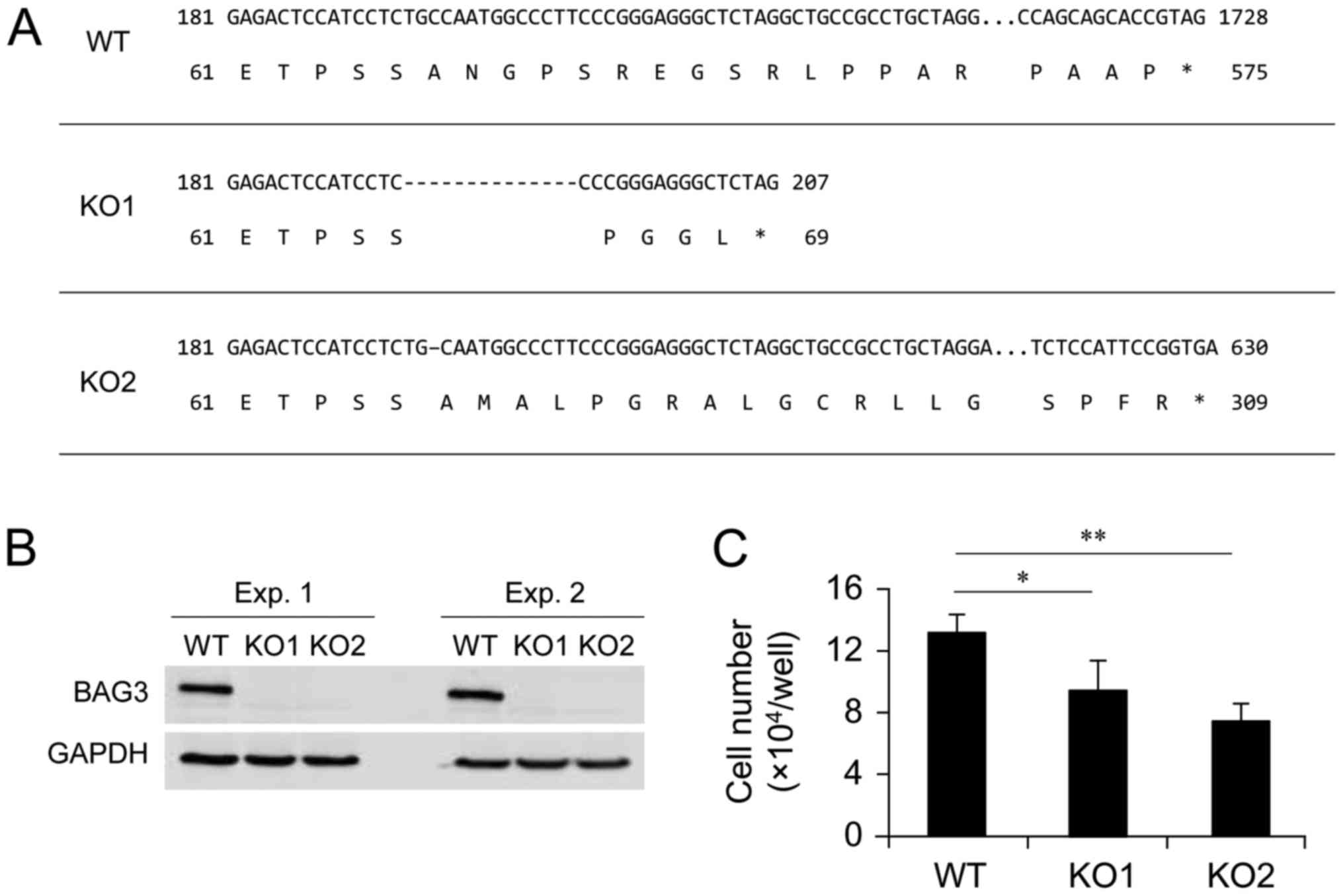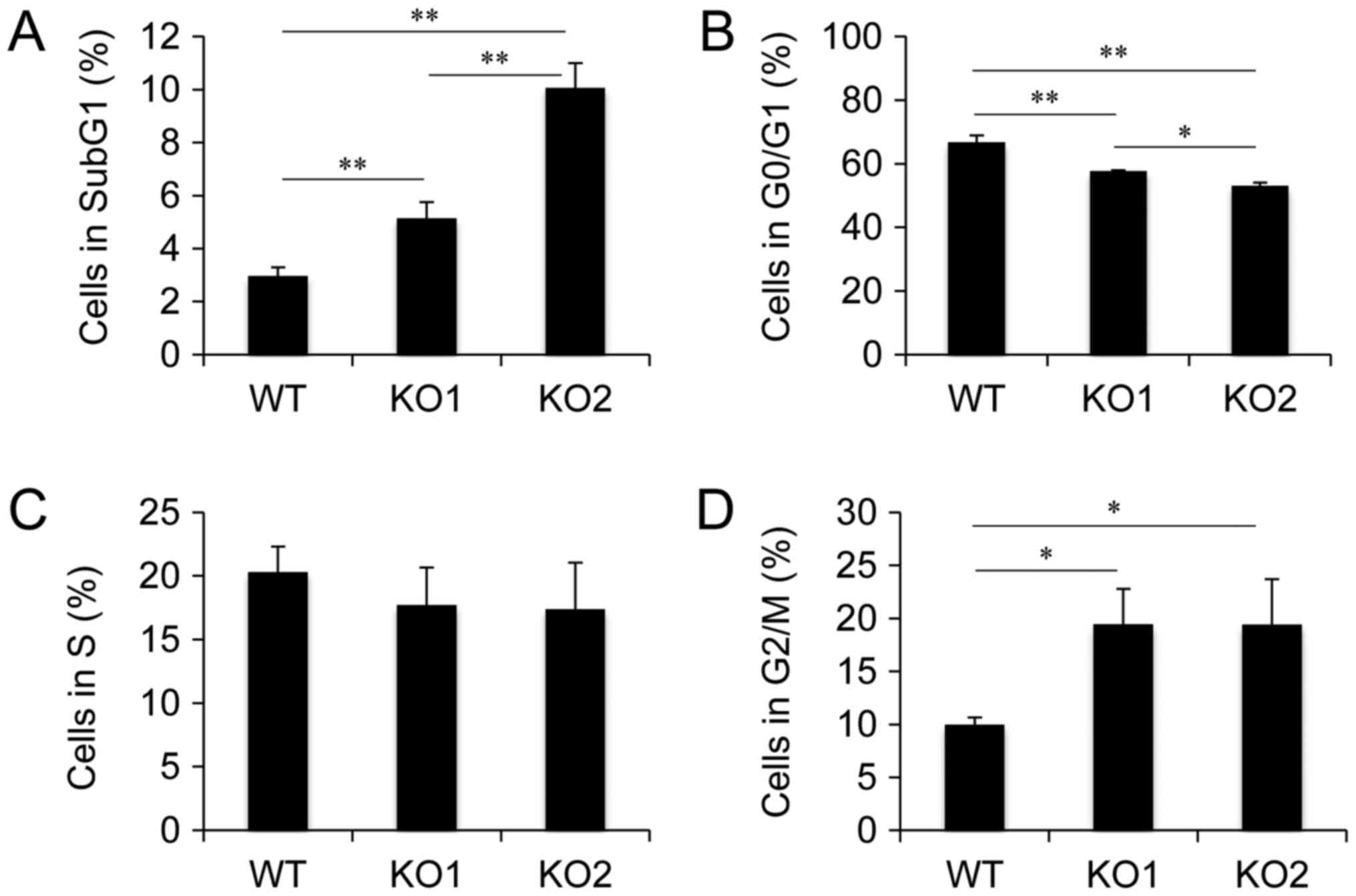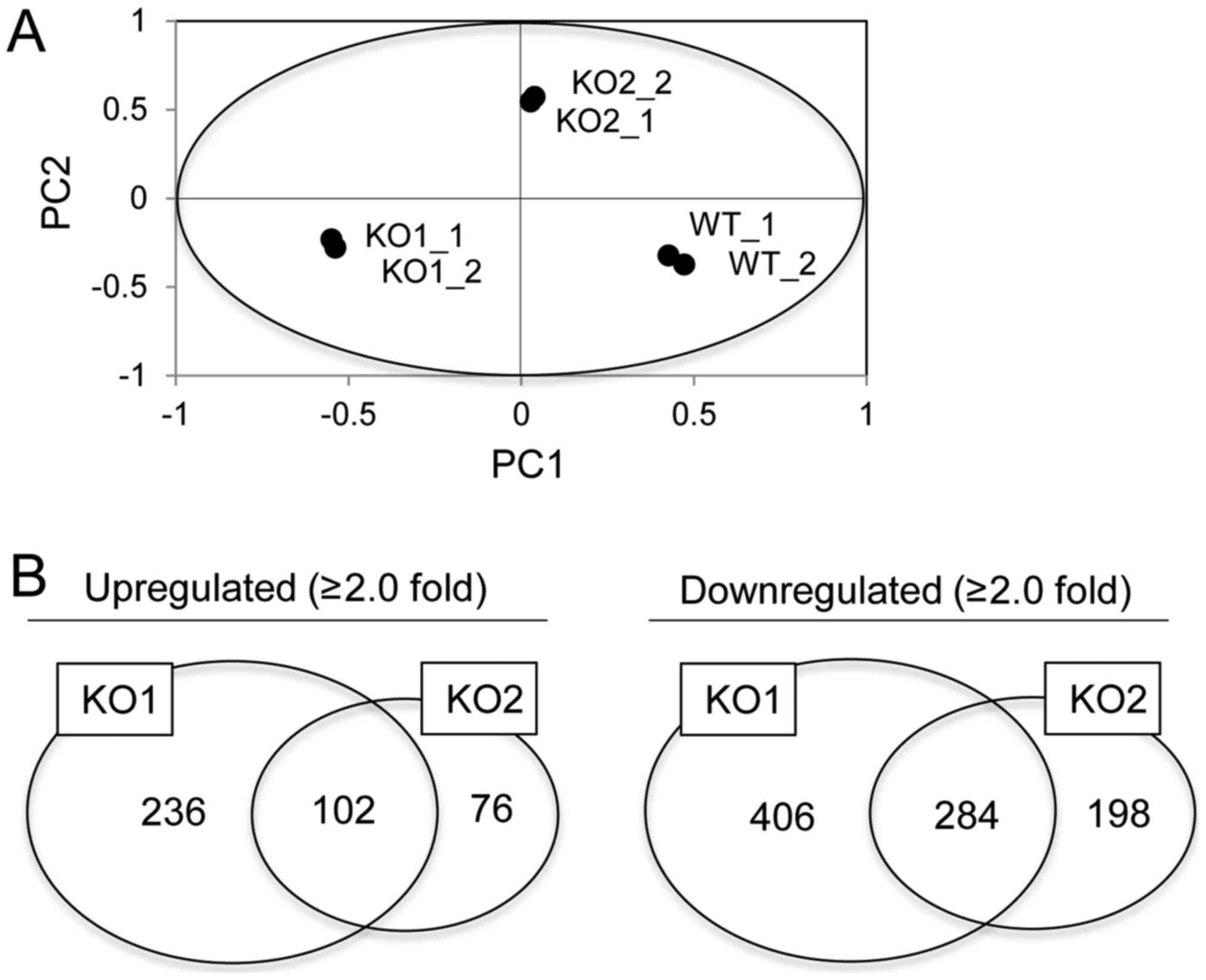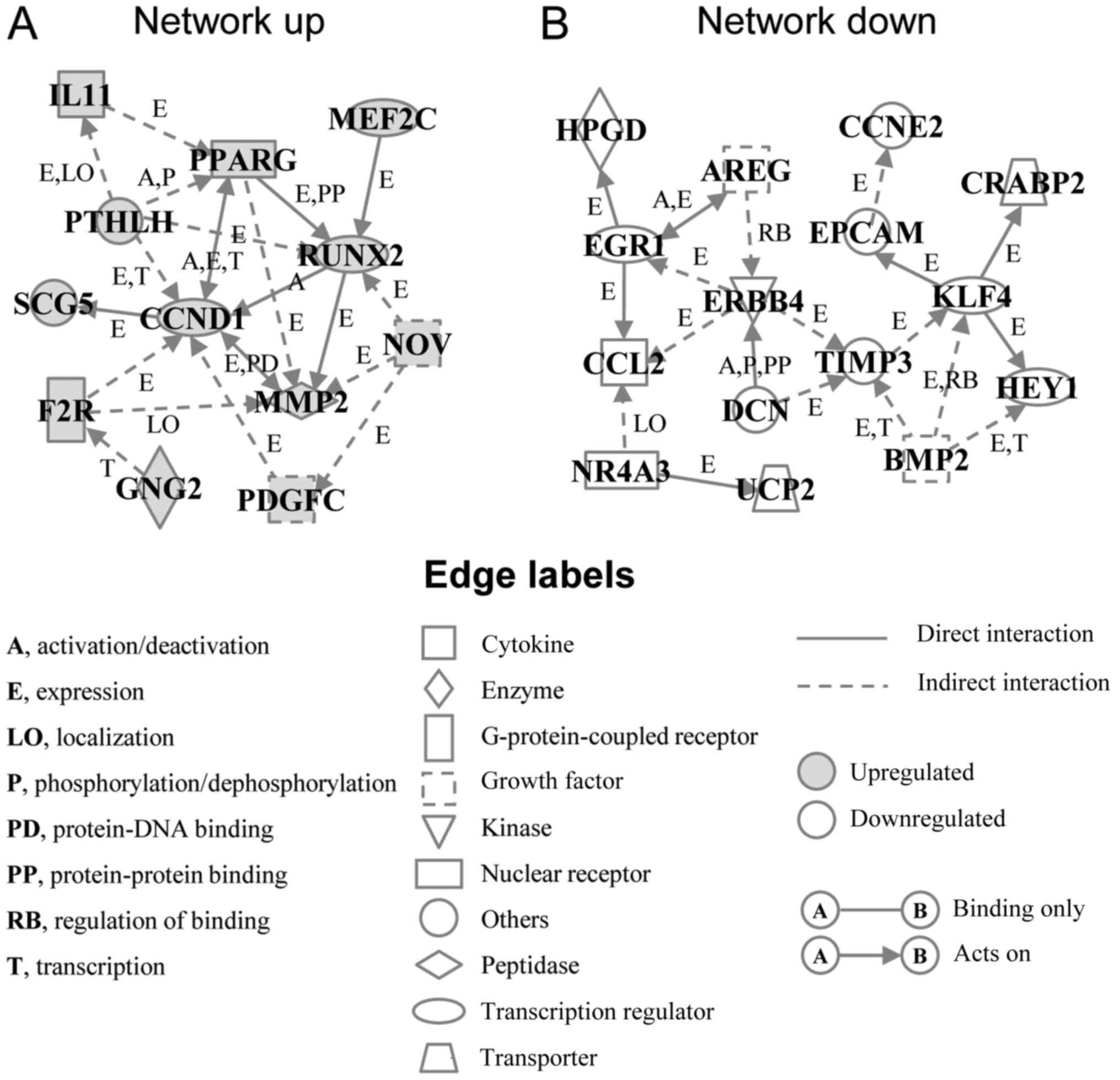|
1
|
Behl C: Breaking BAG: The co-chaperone
BAG3 in health and disease. Trends Pharmacol Sci. 37:672–688. 2016.
View Article : Google Scholar : PubMed/NCBI
|
|
2
|
Rosati A, Ammirante M, Gentilella A,
Basile A, Festa M, Pascale M, Marzullo L, Belisario MA, Tosco A,
Franceschelli S, et al: Apoptosis inhibition in cancer cells: A
novel molecular pathway that involves BAG3 protein. Int J Biochem
Cell Biol. 39:1337–1342. 2017. View Article : Google Scholar
|
|
3
|
Kassis JN, Guancial EA, Doong H, Virador V
and Kohn EC: CAIR-1/BAG-3 modulates cell adhesion and migration by
downregulating activity of focal adhesion proteins. Exp Cell Res.
312:2962–2971. 2006. View Article : Google Scholar : PubMed/NCBI
|
|
4
|
Falco A, Festa M, Basile A, Rosati A,
Pascale M, Florenzano F, Nori SL, Nicolin V, Di Benedetto M,
Vecchione ML, et al: BAG3 controls angiogenesis through regulation
of ERK phosphorylation. Oncogene. 31:5153–5161. 2012. View Article : Google Scholar : PubMed/NCBI
|
|
5
|
Shi H, Xu H, Li Z, Zhen Y, Wang B, Huo S,
Xiao R and Xu Z: BAG3 regulates cell proliferation, migration, and
invasion in human colorectal cancer. Tumour Biol. 37:5591–5597.
2016. View Article : Google Scholar : PubMed/NCBI
|
|
6
|
Suzuki M, Iwasaki M, Sugio A, Hishiya A,
Tanaka R, Endo T, Takayama S and Saito T: BAG3 (BCL2-associated
athanogene 3) interacts with MMP-2 to positively regulate invasion
by ovarian carcinoma cells. Cancer Lett. 303:65–71. 2011.
View Article : Google Scholar : PubMed/NCBI
|
|
7
|
Kathage B, Gehlert S, Ulbricht A, Lüdecke
L, Tapia VE, Orfanos Z, Wenzel D, Bloch W, Volkmer R, Fleischmann
BK, et al: The cochaperone BAG3 coordinates protein synthesis and
autophagy under mechanical strain through spatial regulation of
mTORC1. Biochim Biophys Acta. 1864:62–75. 2017. View Article : Google Scholar : PubMed/NCBI
|
|
8
|
Bonelli P, Petrella A, Rosati A, Romano
MF, Lerose R, Pagliuca MG, Amelio T, Festa M, Martire G, Venuta S,
et al: BAG3 protein regulates stress-induced apoptosis in normal
and neoplastic leukocytes. Leukemia. 18:358–360. 2004. View Article : Google Scholar : PubMed/NCBI
|
|
9
|
Tabuchi Y, Ando H, Takasaki I, Feril LB
Jr, Zhao QL, Ogawa R, Kudo N, Tachibana K and Kondo T:
Identification of genes responsive to low intensity pulsed
ultrasound in a human leukemia cell line Molt-4. Cancer Lett.
246:149–156. 2007. View Article : Google Scholar : PubMed/NCBI
|
|
10
|
Jung SE, Kim YK, Youn DY, Lim MH, Ko JH,
Ahn YS and Lee JH: Down-modulation of Bis sensitizes cell death in
C6 glioma cells induced by oxygen-glucose deprivation. Brain Res.
1349:1–10. 2010. View Article : Google Scholar : PubMed/NCBI
|
|
11
|
Pagliuca MG, Lerose R, Cigliano S and
Leone A: Regulation by heavy metals and temperature of the human
BAG-3 gene, a modulator of Hsp70 activity. FEBS Lett. 541:11–15.
2003. View Article : Google Scholar : PubMed/NCBI
|
|
12
|
Yunoki T, Kariya A, Kondo T, Hayashi A and
Tabuchi Y: The combination of silencing BAG3 and inhibition of the
JNK pathway enhances hyperthermia sensitivity in human oral
squamous cell carcinoma cells. Cancer Lett. 335:52–57. 2013.
View Article : Google Scholar : PubMed/NCBI
|
|
13
|
Yunoki T, Tabuchi Y, Hayashi A and Kondo
T: Network analysis of genes involved in the enhancement of
hyperthermia sensitivity by the knockdown of BAG3 in human oral
squamous cell carcinoma cells. Int J Mol Med. 38:236–242. 2016.
View Article : Google Scholar : PubMed/NCBI
|
|
14
|
Franceschelli S, Rosati A, Lerose R, De
Nicola S, Turco MC and Pascale M: Bag3 gene expression is regulated
by heat shock factor 1. J Cell Physiol. 215:575–577. 2008.
View Article : Google Scholar : PubMed/NCBI
|
|
15
|
Colvin TA, Gabai VL, Gong J, Calderwood
SK, Li H, Gummuluru S, Matchuk ON, Smirnova SG, Orlova NV,
Zamulaeva IA, et al: Hsp70-Bag3 interactions regulate
cancer-related signaling networks. Cancer Res. 74:4731–4740. 2014.
View Article : Google Scholar : PubMed/NCBI
|
|
16
|
Staibano S, Mascolo M, Di Benedetto M,
Vecchione ML, Ilardi G, Di Lorenzo G, Autorino R, Salerno V, Morena
A, Rocco A, et al: BAG3 protein delocalisation in prostate
carcinoma. Tumour Biol. 31:461–469. 2010. View Article : Google Scholar : PubMed/NCBI
|
|
17
|
Tang JT, Wang JL, Du W, Hong J, Zhao SL,
Wang YC, Xiong H, Chen HM and Fang JY: MicroRNA 345, a
methylation-sensitive microRNA is involved in cell proliferation
and invasion in human colorectal cancer. Carcinogenesis.
32:1207–1215. 2011. View Article : Google Scholar : PubMed/NCBI
|
|
18
|
Ammirante M, Rosati A, Arra C, Basile A,
Falco A, Festa M, Pascale M, D'Avenia M, Marzullo L, Belisario MA,
et al: IKK{gamma} protein is a target of BAG3 regulatory activity
in human tumor growth. Proc Natl Acad Sci USA. 107:pp. 7497–7502.
2010; View Article : Google Scholar : PubMed/NCBI
|
|
19
|
Yunoki T, Tabuchi Y, Kondo T, Ishii Y and
Hayashi A: Overexpression of the anti-apoptotic protein BAG3 in
human choroidal melanoma: A case report. Oncol Lett. 13:4169–4172.
2017. View Article : Google Scholar : PubMed/NCBI
|
|
20
|
Boiani M, Daniel C, Liu X, Hogarty MD and
Marnett LJ: The stress protein BAG3 stabilizes Mcl-1 protein and
promotes survival of cancer cells and resistance to antagonist
ABT-737. J Biol Chem. 288:6980–6990. 2013. View Article : Google Scholar : PubMed/NCBI
|
|
21
|
Chen Y, Yang LN, Cheng L, Tu S, Guo SJ, Le
HY, Xiong Q, Mo R, Li CY, Jeong JS, et al: Bcl2-associated
athanogene 3 interactome analysis reveals a new role in modulating
proteasome activity. Mol Cell Proteomics. 12:2804–2819. 2013.
View Article : Google Scholar : PubMed/NCBI
|
|
22
|
Ito T, Hayashida M, Kobayashi S, Muto N,
Hayashi A, Yoshimura T and Mori H: Serine racemase is involved in
d-aspartate biosynthesis. J Biochem. 160:345–353. 2016. View Article : Google Scholar : PubMed/NCBI
|
|
23
|
Furusawa Y, Yamanouchi Y, Iizumi T, Zhao
WL, Mitsuhashi Y, Morita A, Enomoto A, Tabuchi Y and Kondo T:
Checkpoint kinase 2 is dispensable for regulation of the p53
response but is required for G2/M arrest and cell survival in cells
with p53 defects under heat stress. Apoptosis. 22:1225–1234. 2017.
View Article : Google Scholar : PubMed/NCBI
|
|
24
|
Watson JV, Chambers SH and Smith PJ: A
pragmatic approach to the analysis of DNA histograms with a
definable G1 peak. Cytometry. 8:1–8. 1987. View Article : Google Scholar : PubMed/NCBI
|
|
25
|
Hijikata A, Kitamura H, Kimura Y, Yokoyama
R, Aiba Y, Bao Y, Fujita S, Hase K, Hori S, Ishii Y, et al:
Construction of an open-access database that integrates
cross-reference information from the transcriptome and proteome of
immune cells. Bioinformatics. 23:2934–2941. 2007. View Article : Google Scholar : PubMed/NCBI
|
|
26
|
Makino S, Fukumura R and Gondo Y:
Illegitimate translation causes unexpected gene expression from
on-target out-of-frame alleles created by CRISPR-Cas9. Sci Rep.
6:396082016. View Article : Google Scholar : PubMed/NCBI
|
|
27
|
Kwan JA, Schulze CJ, Wang W, Leon H,
Sariahmetoglu M, Sung M, Sawicka J, Sims DE, Sawicki G and Schulz
R: Matrix metalloproteinase-2 (MMP-2) is present in the nucleus of
cardiac myocytes and is capable of cleaving poly (ADP-ribose)
polymerase (PARP) in vitro. FASEB J. 18:690–692. 2004. View Article : Google Scholar : PubMed/NCBI
|
|
28
|
Aldonyte R, Brantly M, Block E, Patel J
and Zhang J: Nuclear localization of active matrix
metalloproteinase-2 in cigarette smoke-exposed apoptotic
endothelial cells. Exp Lung Res. 35:59–75. 2009. View Article : Google Scholar : PubMed/NCBI
|
|
29
|
McDermott U, Ames RY, Iafrate AJ,
Maheswaran S, Stubbs H, Greninger P, McCutcheon K, Milano R, Tam A,
Lee DY, et al: Ligand-dependent platelet-derived growth factor
receptor (PDGFR)-alpha activation sensitizes rare lung cancer and
sarcoma cells to PDGFR kinase inhibitors. Cancer Res. 69:3937–3946.
2009. View Article : Google Scholar : PubMed/NCBI
|
|
30
|
Tang Z, Arjunan P, Lee C, Li Y, Kumar A,
Hou X, Wang B, Wardega P, Zhang F, Dong L, et al: Survival effect
of PDGF-CC rescues neurons from apoptosis in both brain and retina
by regulating GSK3beta phosphorylation. J Exp Med. 207:867–880.
2010. View Article : Google Scholar : PubMed/NCBI
|
|
31
|
Lucero CM, Vega OA, Osorio MM, Tapia JC,
Antonelli M, Stein GS, van Wijnen AJ and Galindo MA: The
cancer-related transcription factor Runx2 modulates cell
proliferation in human osteosarcoma cell lines. J Cell Physiol.
228:714–723. 2013. View Article : Google Scholar : PubMed/NCBI
|
|
32
|
Sugimoto H, Nakamura M, Yoda H, Hiraoka K,
Shinohara K, Sang M, Fujiwara K, Shimozato O, Nagase H and Ozaki T:
Silencing of RUNX2 enhances gemcitabine sensitivity of
p53-deficient human pancreatic cancer AsPC-1 cells through the
stimulation of TAp63-mediated cell death. Cell Death Dis.
6:e19142015. View Article : Google Scholar : PubMed/NCBI
|
|
33
|
Krishnan A, Nair SA and Pillai MR: Biology
of PPAR gamma in cancer: A critical review on existing lacunae.
Curr Mol Med. 7:532–540. 2007. View Article : Google Scholar : PubMed/NCBI
|
|
34
|
Owens TW, Rogers RL, Best S, Ledger A,
Mooney AM, Ferguson A, Shore P, Swarbrick A, Ormandy CJ, Simpson
PT, et al: Runx2 is a novel regulator of mammary epithelial cell
fate in development and breast cancer. Cancer Res. 74:5277–5286.
2014. View Article : Google Scholar : PubMed/NCBI
|
|
35
|
Sharma C, Pradeep A, Pestell RG and Rana
B: Peroxisome proliferator-activated receptor gamma activation
modulates cyclin D1 transcription via beta-catenin-independent and
cAMP-response element-binding protein-dependent pathways in mouse
hepatocytes. J Biol Chem. 279:16927–16938. 2004. View Article : Google Scholar : PubMed/NCBI
|
|
36
|
Shimura T, Ochiai Y, Noma N, Oikawa T,
Sano Y and Fukumoto M: Cyclin D1 overexpression perturbs DNA
replication and induces replication-associated DNA double-strand
breaks in acquired radioresistant cells. Cell Cycle. 12:773–782.
2013. View Article : Google Scholar : PubMed/NCBI
|
|
37
|
Wang G, Woods A, Sabari S, Pagnotta L,
Stanton LA and Beier F: RhoA/ROCK signaling suppresses hypertrophic
chondrocyte differentiation. J Biol Chem. 279:13205–13214. 2004.
View Article : Google Scholar : PubMed/NCBI
|
|
38
|
Parrales A, Palma-Nicolás JP, López E and
López-Colomé AM: Thrombin stimulates RPE cell proliferation by
promoting c-Fos-mediated cyclin D1 expression. J Cell Physiol.
222:302–312. 2010. View Article : Google Scholar : PubMed/NCBI
|
|
39
|
Benini S, Perbal B, Zambelli D, Colombo
MP, Manara MC, Serra M, Parenza M, Martinez V, Picci P and
Scotlandi K: In Ewing's sarcoma CCN3(NOV) inhibits proliferation
while promoting migration and invasion of the same cell type.
Oncogene. 24:4349–4361. 2005. View Article : Google Scholar : PubMed/NCBI
|
|
40
|
Mendoza-Naranjo A, El-Naggar A, Wai DH,
Mistry P, Lazic N, Ayala FR, da Cunha IW, Rodriguez-Viciana P,
Cheng H, Tavares Guerreiro, Fregnani JH, et al: ERBB4 confers
metastatic capacity in Ewing sarcoma. EMBO Mol Med. 5:1087–1102.
2013. View Article : Google Scholar : PubMed/NCBI
|
|
41
|
Capone C, Dabertrand F, Baron-Menguy C,
Chalaris A, Ghezali L, Domenga-Denier V, Schmidt S, Huneau C,
Rose-John S, Nelson MT and Joutel A: Mechanistic insights into a
TIMP3-sensitive pathway constitutively engaged in the regulation of
cerebral hemodynamics. Elife. 5(pii): e175362016. View Article : Google Scholar : PubMed/NCBI
|
|
42
|
Zins K, Pomyje J, Hofer E, Abraham D,
Lucas T and Aharinejad S: Egr-1 upregulates Siva-1 expression and
induces cardiac fibroblast apoptosis. Int J Mol Sci. 15:1538–1553.
2014. View Article : Google Scholar : PubMed/NCBI
|
|
43
|
Baron V, De Gregorio G, Krones-Herzig A,
Virolle T, Calogero A, Urcis R and Mercola D: Inhibition of Egr-1
expression reverses transformation of prostate cancer cells in
vitro and in vivo. Oncogene. 22:4194–4204. 2003. View Article : Google Scholar : PubMed/NCBI
|
|
44
|
Jackson HW, Defamie V, Waterhouse P and
Khokha R: TIMPs: Versatile extracellular regulators in cancer. Nat
Rev Cancer. 17:38–53. 2017. View Article : Google Scholar : PubMed/NCBI
|
|
45
|
Tien YT, Chang MH, Chu PY, Lin CS, Liu CH
and Liao AT: Downregulation of the KLF4 transcription factor
inhibits the proliferation and migration of canine mammary tumor
cells. Vet J. 205:244–253. 2015. View Article : Google Scholar : PubMed/NCBI
|
|
46
|
Liu YN, Abou-Kheir W, Yin JJ, Fang L,
Hynes P, Casey O, Hu D, Wan Y, Seng V, Sheppard-Tillman H, et al:
Critical and reciprocal regulation of KLF4 and SLUG in transforming
growth factor β-initiated prostate cancer epithelial-mesenchymal
transition. Mol Cell Biol. 32:941–953. 2012. View Article : Google Scholar : PubMed/NCBI
|
|
47
|
Kroepil F, Dulian A, Vallböhmer D, Geddert
H, Krieg A, Vay C, Topp SA, Am Esch JS, Baldus SE, Gires O, et al:
High EpCAM expression is linked to proliferation and lauren
classification in gastric cancer. BMC Res Notes. 6:2532013.
View Article : Google Scholar : PubMed/NCBI
|
|
48
|
Liu Z, Shen J, Pu K, Katus HA, Plöger F,
Tiefenbacher CP, Chen X and Braun T: GDF5 and BMP2 inhibit
apoptosis via activation of BMPR2 and subsequent stabilization of
XIAP. Biochim Biophys Acta. 1793:1819–1827. 2009. View Article : Google Scholar : PubMed/NCBI
|
|
49
|
Li Q, Kannan A, Das A, Demayo FJ, Hornsby
PJ, Young SL, Taylor RN, Bagchi MK and Bagchi IC: WNT4 acts
downstream of BMP2 and functions via β-catenin signaling pathway to
regulate human endometrial stromal cell differentiation.
Endocrinology. 154:446–457. 2013. View Article : Google Scholar : PubMed/NCBI
|


















